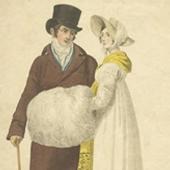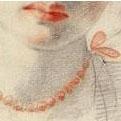A Cameo Appearance : A Regency Accessory
Charlotte was to go: with excellent health, to bathe and be better if she could; to receive every possible pleasure which Sanditon could be made to supply by the gratitude of those she went with; and to buy new parasols, new gloves and new brooches for her sisters and herself at the library, which Mr. Parker was anxiously wishing to support. - Sanditon
Cameos seem an essential Regency accessory. Often portraying Greek or Roman scenes and faces, they evoke a romantic mood and whispers of a time long past. In reality, though, these charming vignettes of time gone by hearken back over thousands, not hundreds of years. The word cameo, actually refers to the method of carving an object such as an engraved gem, item of jewellery or vessel. These nearly always feature a raised (positive) relief image (in contrast with intaglio, which has a negative image.) Originally, cameo only referred to works where the relief image was of a contrasting colour to the background; this was achieved by carefully carving a piece of material with a flat plane where two contrasting colours met, removing all the first colour except for the image to leave a contrasting background.
 Cameos were often worn as Regency accessories, but in ancient times were mainly used for signet rings, although the largest examples were probably too large for this, and were just admired as objets d'art. Stone cameos of great artistry were made in Greece dating back as far as the 3rd century BC. The Farnese Tazza (a cup) is the oldest major Hellenistic piece surviving. They were very popular in Ancient Rome, especially in the family circle of Augustus. The most famous stone "state cameos" from this period are the Gemma Augustea, the Gemma Claudia made for the Emperor Claudius, and the largest flat engraved gem known from antiquity, the Great Cameo of France.
Cameos were often worn as Regency accessories, but in ancient times were mainly used for signet rings, although the largest examples were probably too large for this, and were just admired as objets d'art. Stone cameos of great artistry were made in Greece dating back as far as the 3rd century BC. The Farnese Tazza (a cup) is the oldest major Hellenistic piece surviving. They were very popular in Ancient Rome, especially in the family circle of Augustus. The most famous stone "state cameos" from this period are the Gemma Augustea, the Gemma Claudia made for the Emperor Claudius, and the largest flat engraved gem known from antiquity, the Great Cameo of France.  Of course, cameos are much older than Regency accessories. During the Roman period the cameo technique was used on artificial glass blanks, in imitation of objects being produced in agate or sardonyx. Cameo glass objects were produced in two periods; between around 25 BC and 50/60 AD, and in the later Empire around the mid-third and mid-fourth century. Roman glass cameos are rare objects, with only around two hundred fragments and sixteen complete pieces known, only one of which dates from the later period. During the early period they usually consisted of a blue glass base with a white overlying layer, but those made during the later period usually have a colourless background covered with a translucent coloured layer. Blanks could be produced by fusing two separately cast sheets of glass, or by dipping the base glass into a crucible of molten overlay glass during blowing. The most famous example of a cameo from the early period is the Portland Vase.
Of course, cameos are much older than Regency accessories. During the Roman period the cameo technique was used on artificial glass blanks, in imitation of objects being produced in agate or sardonyx. Cameo glass objects were produced in two periods; between around 25 BC and 50/60 AD, and in the later Empire around the mid-third and mid-fourth century. Roman glass cameos are rare objects, with only around two hundred fragments and sixteen complete pieces known, only one of which dates from the later period. During the early period they usually consisted of a blue glass base with a white overlying layer, but those made during the later period usually have a colourless background covered with a translucent coloured layer. Blanks could be produced by fusing two separately cast sheets of glass, or by dipping the base glass into a crucible of molten overlay glass during blowing. The most famous example of a cameo from the early period is the Portland Vase.
 Although occasionally used in Roman cameos, the earliest prevalent use of shell for cameo carving was during the Renaissance. In the mid 18th century, explorations revealed new shell varieties. Helmet shells (Cassis tuberosa) from the West Indies, and queen conch shells (Eustrombus gigas) from the Bahamas and West Indies, arrived in Europe. This sparked a large increase in the number of cameos that were carved from shells.
Although occasionally used in Roman cameos, the earliest prevalent use of shell for cameo carving was during the Renaissance. In the mid 18th century, explorations revealed new shell varieties. Helmet shells (Cassis tuberosa) from the West Indies, and queen conch shells (Eustrombus gigas) from the Bahamas and West Indies, arrived in Europe. This sparked a large increase in the number of cameos that were carved from shells.
In Britain, this revival first occurred during King George III's reign. As with many fashion trends of the time, this one was imported from France and stemmed from a heightened interest in ancient Egypt, Greece and Rome, due to Napoleon's campaigns in the south. A cameo diadem carved from a single shell, depicting a scene from Greek mythology, framed by gold, pearls and precious and semiprecious stones, was a present to Josephine from her brother-in-law Joachim Murat in 1811.  Napoleon, himself, was fascinated by cameos, and as you can see, Josephine, who did nothing by halves, had a large collection of them set in pins, bracelets, combs, and more.
Napoleon, himself, was fascinated by cameos, and as you can see, Josephine, who did nothing by halves, had a large collection of them set in pins, bracelets, combs, and more.  In Britain, King George's granddaughter, Queen Victoria, was a major proponent of the cameo trend, to the extent that they would become mass produced by the second half of the 19th century. After 1850 demand for cameos grew, as they became popular souvenirs of the Grand Tour among the middle class.
In Britain, King George's granddaughter, Queen Victoria, was a major proponent of the cameo trend, to the extent that they would become mass produced by the second half of the 19th century. After 1850 demand for cameos grew, as they became popular souvenirs of the Grand Tour among the middle class.  Cameos continue to be popular jewelry subjects for pins, necklaces, rings, hair clips, earrings and more. Both vintage and new models can be found for sale with little searching; perhaps because they evoke a romantic feel...perhaps because they are so innately elegant. However you look at it though, cameos continue to be one of the longest lasting jewelry trends in history.
Cameos continue to be popular jewelry subjects for pins, necklaces, rings, hair clips, earrings and more. Both vintage and new models can be found for sale with little searching; perhaps because they evoke a romantic feel...perhaps because they are so innately elegant. However you look at it though, cameos continue to be one of the longest lasting jewelry trends in history.
Enjoyed this article? If you don't want to miss a beat when it comes to Jane Austen, make sure you are signed up to the Jane Austen newsletter for exclusive updates and discounts from our Online Gift Shop.




Leave a comment
This site is protected by hCaptcha and the hCaptcha Privacy Policy and Terms of Service apply.